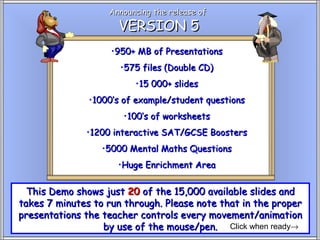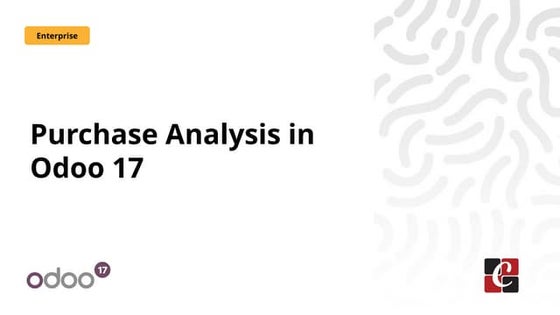Graph functions
- 1. Announcing the release of VERSION 5 ?950+ MB of Presentations ?575 files (Double CD) ?15 000+ slides ?1000Ī»s of example/student questions ?100Ī»s of worksheets ?1200 interactive SAT/GCSE Boosters ?5000 Mental Maths Questions ?Huge Enrichment Area This Demo shows just 20 of the 15,000 available slides and takes 7 minutes to run through. Please note that in the proper presentations the teacher controls every movement/animation by use of the mouse/pen. Click when readyĪ·
- 2. Whiteboardmaths.com Stand SW 100 ? 2004 - 2007 All rights reserved Click when ready Ī· In addition to the demos/free presentations in this area there are at least 8 complete (and FREE) presentations waiting for download under the My Account button. Simply register to download immediately.
- 3. This is a short demo that auto-runs. Drawing the graph of a quadratic function?
- 4. 8 y 7 Equation Drawing quadratic graphs of LoS 6 of Line of the form y = ax2 + bx + c symmetry 5 is x = 1 Example 1. 4 3 y = x2 - 2x - 8 2 x -3 -2 -1 0 1 2 3 4 5 1 x -3 -2 -1 0 1 2 3 4 5 x2 9 4 1 0 1 4 9 16 25 -1 -2x 6 4 2 0 -2 -4 -6 -8 -10 -2 -3 -8 -8 -8 -8 -8 -8 -8 -8 -8 -8 -4 y 7 0 -5 -8 -9 -8 -5 0 7 -5 -6 Minimum point -7 -8 at (1, -9) -9
- 5. Look at graphs of some trig functions?
- 6. 90o The -360 -270 -180 -90 0 90 180 270 360 Trigonometric Ratios for any 180o 0o angle -360 -270 -180 -90 0 90 180 270 360 -450o -360o -270o -180o -90o 0o 90o 180o 270o 360o 450o 270o 1 sinx + circle 0o 90o 180o 270o 360o ”╚ -1
- 7. y = f(x) f(x) = cosx f(x) = cos2x f(x) = cos3x f(x) = cos ? x 2 1 x -360 -270 -180 -90 0 90 180 270 360 -1 -2
- 8. Introducing addition of fractions with different denominators?
- 9. 2 1 + 3 4 Equ t len 3 va qui ival + E 8 ent Multiples of 12 3 and 4 12 3 4 6 8 11 9 12 = 12 16 12 15 20 12 is the LCM
- 11. Conditional Probability: Dependent Events When events are not independent, the outcome of earlier events affects the outcome of later events. This happens in situations when the objects selected are not replaced.
- 12. Conditional Probability: Dependent Events A box of chocolates contains twelve chocolates of three different types. There are 3 strawberry, 4 caramel and 5 milk chocolates in the box. Sam chooses a chocolate at random and eats it. Jenny then does the same. Calculate the probability that they both choose a strawberry chocolate. P(strawberry and strawberry) = 3/12 x
- 13. Conditional Probability: Dependent Events A box of chocolates contains twelve chocolates of three different types. There are 3 strawberry, 4 caramel and 5 milk chocolates in the box. Sam chooses a chocolate at random and eats it. Jenny then does the same. Calculate the probability that they both choose a strawberry chocolate. P(strawberry and strawberry) = 3/12 x 2/11 = 6/132 (1/22)
- 15. Enlargements from a Given Point Centre of Enlargement To enlarge the kite by B scale factor x3 from the point shown. A Object C B/ 1. Draw the ray lines through vertices. D 2. Mark off x3 distances C/ along lines from C of E. A / Image 3. Draw and label image. No Grid 2 D/
- 16. Do some Loci?
- 17. Loci (Dogs and Goats) Q2 Billy the goat is tethered by a 15m long chain to a tree at A. Nanny the goat is tethered to the corner of a shed at B by a 12 m rope. Draw the boundary locus for both goats and shade the region that they can both occupy. Wall Scale:1cm = 3m A Shed B Wall 1. Draw arc of circle of radius 5 cm 2. Draw ? circle of radius 4 cm 3. Draw a ? circle of radius 1 cm 4. Shade in the required region.
- 18. Investigate some Properties of ▒╩▓╣▓§│”▓╣▒¶Ī»▓§ Triangle
- 19. ▒╩▓╣▓§│”▓╣▒¶Ī»▓§ 1 1. Complete the rest of the triangle. Triangle 1 1 1 2 1 1 3 3 1 Counting/Natural Numbers 1 4 6 4 1 Blais©” Pascal (1623-1662) 1 5 10 10 5 1 Triangular Numbers 1 6 15 20 15 6 1 1 7 21 35 35 21 7 1 1 8 28 56 70 56 28 8 1 1 9 36 84 126 126 84 36 9 1 Tetrahedral Numbers 1 10 45 120 210 252 210 120 45 10 1 1 ▒╩▓╣▓§│”▓╣▒¶Ī»▓§ 11 55 165 330 462 462 330 165 55 11 1 1 12 66 220 495Triangle 792 924 792 495 220 66 12 1 Pyramid Numbers 1 13 78 286 715 1287 1716 1716 1287 715 286 78 13 1 (square base)
- 20. 1 The Fibonacci Sequence Add the numbers shown along each of the 1 1 1 1 2 3 5 8 13 shallow diagonals to find Leonardo of Pisa another well known 1 2 1 21 34 55 89 144 233 377 1180 - 1250 sequence of numbers. 1 3 3 1 The sequence first appears as a Fibonacci travelled 1 4 6 4 1 recreational maths problem extensively throughout about the growth in population the Middle East and 1 5 10 10 5 1 of rabbits in book 3 of his elsewhere. He strongly famous work, Liber ©C abaci (the recommended that 1 6 15 20 15 6 1 book of the calculator). Europeans adopt the 1 7 21 35 35 21 7 1 Indo-Arabic system of numerals including the 1 8 28 56 70 56 28 8 1 use of a symbol for zero Ī░zephirumĪ▒ 1 9 36 84 126 126 84 36 9 1 1 10 45 120 210 252 210 120 45 10 1 1 Fibonacci 11 55 165 330 462 462 330 165 55 11 1 1 12 Sequence 66 220 495 792 924 792 495 220 66 12 1 1 13 78 286 715 1287 1716 1716 1287 715 286 78 13 1
- 21. National Lottery Jackpot? Row 0 49 balls choose 6 12 49 11 33 15 21 38 7 30 36 31 25 17 24 20 1 35 45 3 14 13 49 C6 37 19 43 39 22 16 40 44 9 4 46 There are 13 983 816 ways of 47 32 34 choosing 6 balls from a set of 8 2 49. So buying a single ticket 29 means that the probability of a 23 26 5 42 win is 1/13 983 816 6 10 41 18 28 Choose 6 27 Row 49 13 983 816 48
- 22. The Theorem of Pythagoras?
- 23. A 3 rd Pythagorean Triple In a right-angled triangle, the square on the 625 hypotenuse is equal to the sum of the squares 7, 24, 25 on the other two sides. 25 49 7 24 576 7 2 + 24 2 = 25 2 49 + 576 = 625
- 24. The Theorem of Pythagoras: A Visual Demonstration In a right-angled triangle, the square on the hypotenuse is equal to the sum of the squares on the other two sides. Henry Perigal (1801 ©C 1898) PerigalĪ»s Dissection Gravestone Inscription ?Draw 2 lines through the centre of the middle square, parallel to the sides of the large square ?This divides the middle square into 4 congruent quadrilaterals ?These quadrilaterals + small square fit exactly into the large square
- 25. Look at one of the 6 proofs of the Theorem from the Pythagorean Treasury.
- 26. President James GarfieldĪ»s Proof(1876) To prove that a2 + b2 = c2 We first need to show that the angle between angle x and angle y is a right angle. ?This angle is 90o since x + y = 90o (angle sum of a triangle) and angles on a straight line add to 180o ? Draw line:The boundary shape is a trapezium Area of trapezium = ? (a + b)(a + b) = ? (a2 +2ab + b2) yo Area of trapezium is also equal to the areas of the 3 right-angled triangles. = ? ab + ? ab + ? c2 c b So xo ? ? (a2 +2ab + b2) = ? ab + ? ab + ? c2 c a ? a2 +2ab + b2 = 2ab + c2 yo xo ? a 2 + b2 = c2 QED b a Take 1 identical copy of this right-angled triangle and arrange like so.
- 27. Sample some material from the Golden section presentation.
- 28. THE GOLDEN SECTION Constructing a Golden Rectangle. 1. Construct a square and the 2. Extend the sides as shown. perpendicular bisector of a side to find its midpoint p. L M Q 3. Set compass to 1 length PM and draw an arc as shown. O P N R 4. Construct a LQRO is a Golden Rectangle. perpendicular QR.
- 29. THE GOLDEN SECTION "Geometry has two great treasures: one is the Theorem of Pythagoras, and the other the division of a line into extreme and mean ratio; the first we may compare to a measure of gold, the second we may name a precious jewel." Johannes Kepler 1571- 1630
- 30. Or just simply ride your bike!
- 31. Wheels in Motion Choose The Cycloid Order Forms/New for V5 to view latest material and other catalogues. ItĪ»s true! The point at the bottom of a moving wheel is not moving! Wheel
- 32. Whiteboardmaths.com Stand SW 100 ? 2004 - 2007 All rights reserved Click when ready Ī· DonĪ»t forget to pick up your 8 free presentations.





























































































